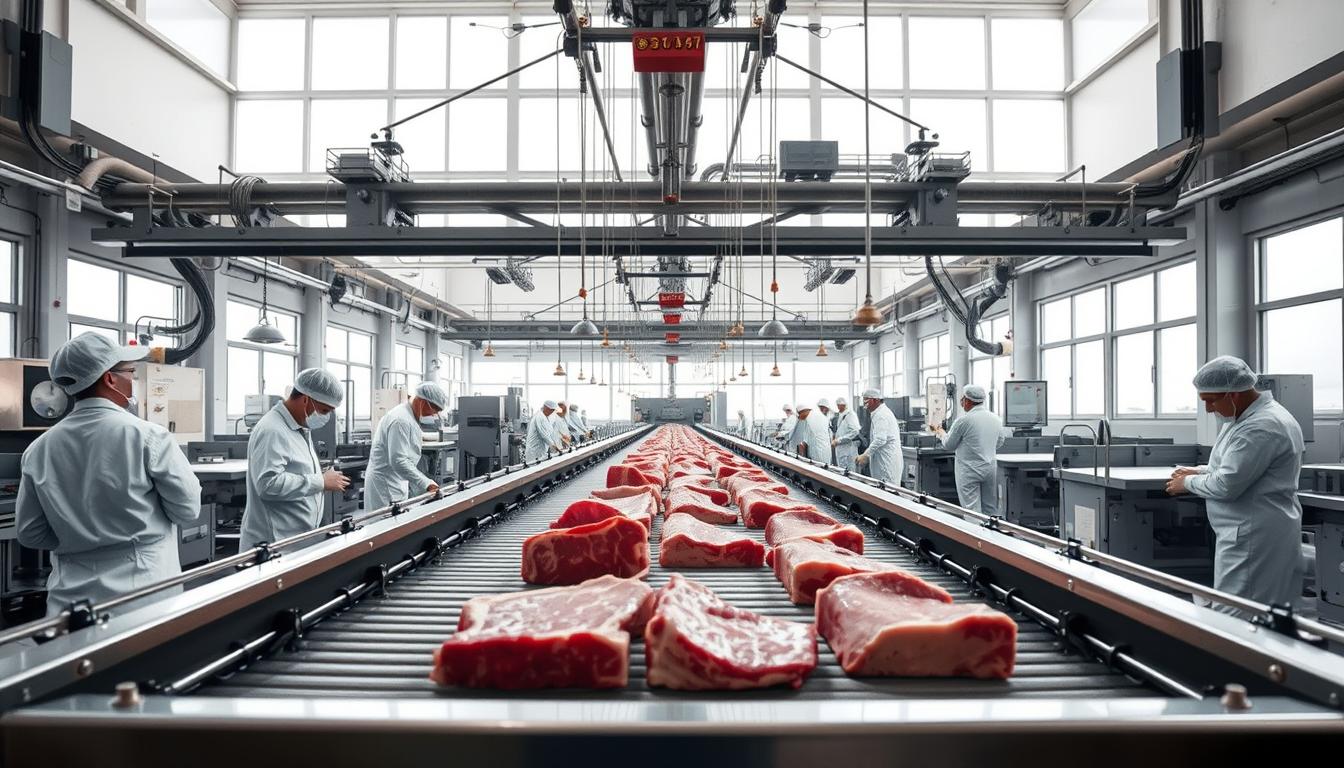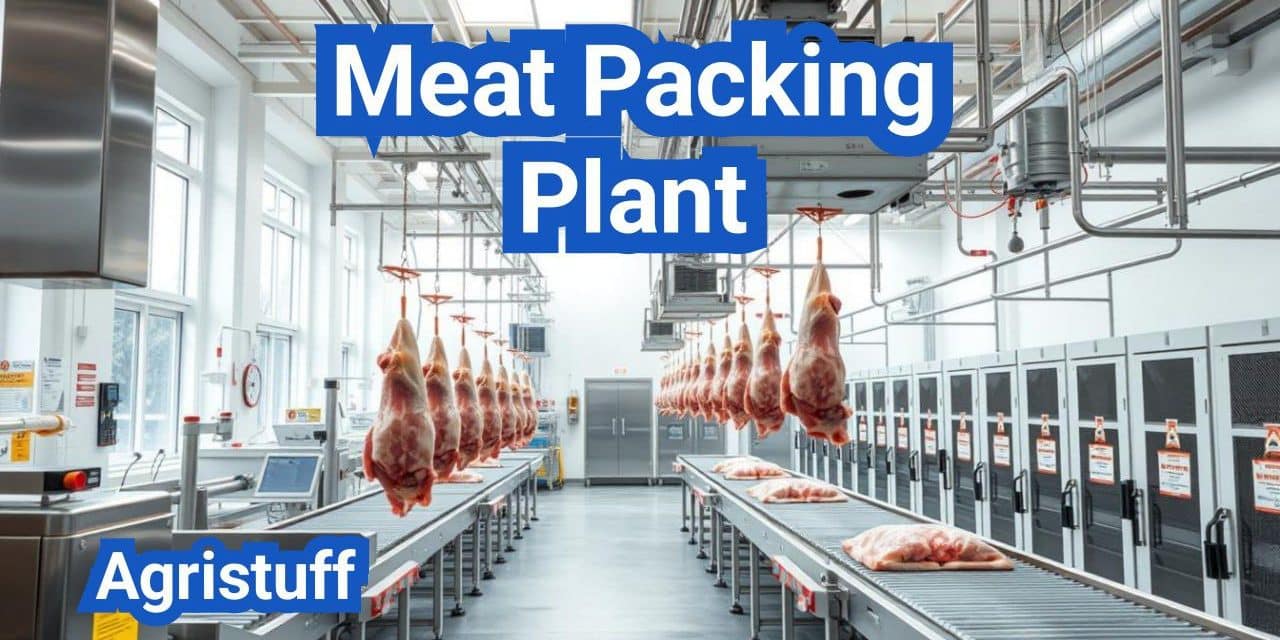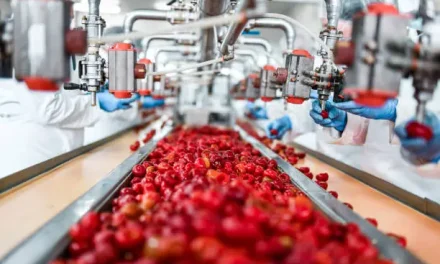The meat packing industry is a complex and highly regulated sector, with facilities operating under strict guidelines to ensure food safety and worker protection. The U.S. Department of Agriculture’s Food Safety Inspection Service, in collaboration with OSHA, plays a crucial role in overseeing these operations.
Recently, select pork-processing facilities have been allowed to operate at increased line speeds, a move that has implications for both productivity and safety. Understanding the intricacies of meat packing plant design and the regulatory framework governing daily operations is essential for industry stakeholders.
Compliance with OSHA requirements and USDA rules is paramount, affecting every aspect of the facility’s operations, from sanitation practices to employee training programs.
Key Takeaways
- The meat packing industry is subject to stringent regulations.
- Recent changes allow select facilities to operate at increased line speeds.
- Compliance with OSHA and USDA regulations is critical.
- Meat packing plant design significantly impacts operational efficiency.
- Daily operations are influenced by regulatory requirements.
The Evolution of the Modern Meat Packing Industry
The evolution of the meat packing industry reflects broader changes in technology, regulations, and consumer demand. Over the years, this industry has transformed significantly, from its early practices to current standards.
From Historical Practices to Current Standards
The meat packing industry has its roots in the 1800s, when the first meatpacking plants were established. Initially, the industry was characterized by harsh working conditions and primitive processing techniques. However, with advancements in technology and changes in regulations, the industry has evolved to prioritize food safety and worker welfare.
The early 20th century saw the introduction of new processing technologies and the implementation of initial regulatory frameworks. The industry continued to grow, with significant changes in the latter half of the century, including the introduction of more stringent food safety regulations and improvements in working conditions.
Major Players in U.S. Meat Processing
The U.S. meatpacking industry is dominated by a few major players, including Tyson Foods, JBS USA, and National Beef. These companies have significant market share and influence the overall direction of the industry.
- Tyson Foods: One of the largest meat processing companies in the world.
- JBS USA: A subsidiary of the global JBS group, known for its extensive meat processing operations.
- National Beef: A major player in the U.S. beef processing market.
Economic Impact and Market Concentration
The meat packing industry has a substantial economic impact on the U.S. economy, providing employment to thousands and contributing to the country’s GDP. However, the industry has also faced challenges related to market concentration, with a few large companies controlling a significant portion of the market.
This concentration has raised concerns about price fixing and competition. Regulatory bodies have been monitoring the situation to ensure fair practices and maintain a competitive market.
Planning Your Meat Packing Plant Layout
Effective planning of a meat packing plant’s layout is vital for maintaining high standards of sanitation and safety. A well-designed layout not only ensures compliance with regulatory requirements but also enhances operational efficiency.
Site Selection and Facility Requirements
The first step in planning a meat packing plant is selecting an appropriate site. The location should be easily accessible for livestock transportation and have sufficient space for future expansion. Zoning regulations and environmental impact assessments are critical factors to consider during site selection.
Facility requirements include adequate ventilation systems, waste management facilities, and sanitation infrastructure. The plant must be designed to prevent cross-contamination and ensure a smooth flow of operations from receiving to packaging.
| Facility Component | Description | Importance |
|---|---|---|
| Ventilation System | Controls air quality and temperature | High |
| Waste Management | Handles disposal of waste materials | High |
| Sanitation Infrastructure | Supports cleaning and sanitizing operations | Critical |
Processing Flow Optimization
Optimizing the processing flow is essential for maximizing efficiency and minimizing delays. This involves analyzing each stage of the production process, from livestock receiving to final product packaging, and identifying areas for improvement.
Key considerations include minimizing product travel distance, reducing handling times, and implementing a logical sequence of operations. Lean manufacturing principles can be applied to eliminate waste and improve productivity.
Equipment Selection and Placement Strategies
The selection and placement of equipment are critical for maintaining a smooth and efficient production line. Equipment should be chosen based on its ability to meet production demands, ease of cleaning, and compliance with safety standards.
Strategic placement of equipment can significantly reduce production time and improve product quality. Factors such as ergonomic considerations, maintenance accessibility, and sanitation requirements should be taken into account when determining equipment placement.
Navigating the Regulatory Framework for Meat Processing

Meat processing facilities must comply with a complex regulatory framework to ensure food safety, workplace safety, and environmental protection. This framework involves regulations from various government agencies, including the USDA, OSHA, and EPA.
USDA Food Safety and Inspection Service Requirements
The USDA’s Food Safety and Inspection Service (FSIS) is responsible for ensuring that meat, poultry, and egg products are safe for consumption. FSIS regulations cover various aspects, including:
- Sanitation and hygiene practices
- Pathogen control measures
- Labeling and packaging requirements
- Inspection and testing protocols
Meat processing facilities must adhere to these regulations to avoid non-compliance issues, which can result in significant fines and reputational damage.
“The safety of the food supply is our top priority. We work to ensure that the food Americans eat is safe, wholesome, and properly labeled.”
USDA FSIS Mission Statement
OSHA Workplace Safety Standards
The Occupational Safety and Health Administration (OSHA) sets standards for workplace safety, aiming to reduce injuries and illnesses among employees. Key OSHA requirements for meat processing facilities include:
| OSHA Standard | Description |
|---|---|
| Hazard Communication | Requires employers to inform employees about hazardous chemicals in the workplace. |
| Lockout/Tagout | Mandates procedures for controlling hazardous energy during equipment maintenance. |
| Personal Protective Equipment | Specifies requirements for PPE to protect employees from workplace hazards. |
Compliance with OSHA standards is crucial for maintaining a safe working environment and minimizing the risk of workplace accidents.
EPA Environmental Compliance
The Environmental Protection Agency (EPA) regulates environmental aspects of meat processing, including wastewater treatment and disposal, air emissions, and hazardous waste management. Facilities must comply with EPA regulations to prevent environmental pollution and protect public health.
Key EPA requirements include:
- Obtaining permits for air and water emissions
- Implementing best management practices for wastewater treatment
- Proper disposal of hazardous waste
By adhering to these regulations, meat processing facilities can minimize their environmental footprint and ensure sustainable operations.
How to Develop an Effective HACCP Plan
In the meat processing industry, creating an effective HACCP plan is vital for identifying and controlling potential hazards. A well-designed HACCP plan ensures that meat packing plants maintain high standards of food safety and comply with regulatory requirements.
Identifying Critical Control Points
The first step in developing a HACCP plan is to identify critical control points (CCPs) within the meat processing operation. CCPs are points at which control can be applied to prevent, eliminate, or reduce a food safety hazard to an acceptable level. Examples of CCPs in meat processing include cooking, chilling, and packaging.
Critical control points are determined through a thorough hazard analysis, considering factors such as the source of raw materials, processing procedures, and the intended use of the final product.
Establishing Monitoring Procedures
Once CCPs are identified, monitoring procedures must be established to ensure that these points are under control. Monitoring involves systematic observations and measurements to assess whether a CCP is operating within established limits.
Effective monitoring procedures may include temperature checks during cooking or cooling processes, visual inspections of packaging for integrity, and microbiological testing of products.
Creating Verification and Documentation Systems
Verification procedures are essential to confirm that the HACCP plan is working effectively. This includes activities such as reviewing monitoring records, conducting regular audits, and performing validation studies to ensure that the HACCP plan achieves its intended purpose.
Documentation is a critical component of a HACCP plan, providing evidence of compliance with food safety regulations and supporting traceability in case of product recalls or safety issues.
By following these steps and maintaining a robust HACCP plan, meat packing plants can ensure the production of safe and wholesome products, complying with regulatory requirements and protecting consumer health.
Implementing Sanitation Standard Operating Procedures (SSOP)

Sanitation Standard Operating Procedures (SSOP) are vital for maintaining a clean environment in meat processing facilities. These procedures are designed to prevent contamination and ensure the safety of the products being processed.
Pre-operational Sanitation Requirements
Before starting operations, meat packing plants must ensure that all areas are thoroughly cleaned and sanitized. This includes the removal of any debris, dirt, or previous day’s residue. Pre-operational sanitation involves a series of steps that are crucial for maintaining a hygienic environment.
The process typically begins with a thorough cleaning to remove any visible dirt or debris. This is followed by sanitizing, where approved sanitizers are used to kill any remaining bacteria or pathogens.
Operational Sanitation Protocols
During operations, maintaining sanitation is equally important. Operational sanitation protocols are put in place to ensure that the facility remains clean throughout the production process.
This involves regular cleaning schedules, where equipment and work areas are cleaned at designated intervals. Additionally, employees are trained to maintain cleanliness by following proper hygiene practices, such as washing hands regularly and wearing appropriate protective gear.
Sanitation Verification and Record-Keeping
To ensure that SSOPs are effective, regular verification is necessary. This involves monitoring and recording sanitation activities to identify any areas that may need improvement.
Record-keeping is a critical component of SSOPs, as it provides a traceable history of sanitation activities. These records are not only essential for internal quality control but are also required by regulatory bodies to ensure compliance with sanitation standards.
By implementing robust SSOPs, meat packing plants can significantly reduce the risk of contamination, ensuring a safer product for consumers and compliance with regulatory requirements.
Meat Packing Plant Line Design Essentials
Meat packing plant line design is a complex process that requires careful planning to optimize production flow and meet stringent regulatory requirements. Effective line design is critical for efficient meat processing and compliance with regulations.
Receiving and Holding Area Configuration
The receiving and holding area is the first point of contact for livestock arriving at the meat packing plant. Efficient design of this area is crucial for ensuring the humane handling of animals and maintaining their health. The layout should facilitate easy unloading, provide adequate space for animal holding pens, and include proper ventilation and waste management systems.
Key considerations for the receiving and holding area include:
- Adequate space for the number of animals being processed
- Proper ventilation to reduce stress on the animals
- Effective waste management to prevent disease
- Easy access for veterinary inspections
Slaughter Floor Layout and Equipment
The slaughter floor is where the actual processing of livestock into meat products begins. A well-designed slaughter floor layout is essential for maintaining efficiency, ensuring worker safety, and complying with regulatory standards. The layout must accommodate various stages of the slaughter process, including stunning, bleeding, and evisceration, in a logical and efficient sequence.
Key elements to consider in the slaughter floor layout include:
- Positioning of stunning and bleeding equipment
- Evisceration and carcass handling systems
- Worker safety features, such as non-slip flooring and protective barriers
- Sanitation stations for equipment and personnel
Fabrication Department Design
The fabrication department is responsible for cutting, trimming, and packaging meat products. Efficient design of this department is vital for maximizing productivity and maintaining product quality. The layout should facilitate a smooth workflow, minimize product handling, and ensure compliance with food safety regulations.
| Design Element | Description | Benefit |
|---|---|---|
| Workflow Optimization | Logical sequence of operations | Increased Efficiency |
| Sanitation Stations | Regular cleaning and disinfection | Improved Food Safety |
| Product Handling | Minimized manual handling | Reduced Risk of Contamination |
By focusing on these key areas, meat packing plants can achieve a more efficient and compliant line design, ultimately enhancing their overall performance and product quality.
Optimizing Line Speed and Production Efficiency

As the demand for meat products grows, plants are under pressure to increase line speeds while maintaining high standards of quality and safety. Optimizing line speed and production efficiency is crucial for the competitiveness and profitability of meat packing plants.
Determining Appropriate Line Speeds
Determining the appropriate line speed involves balancing production needs with safety and quality considerations. The USDA has allowed select pork-processing facilities to operate at increased line speeds, citing research that shows no direct link between line speeds and workplace injuries. However, it’s essential to conduct thorough risk assessments and implement robust safety measures.
Key factors to consider when determining line speeds include:
- Production capacity and demand
- Workforce skills and training
- Equipment capabilities and maintenance
- Safety protocols and risk management
Balancing Efficiency with Safety and Quality
Balancing efficiency with safety and quality is a delicate task. Implementing lean manufacturing principles can help streamline processes and reduce waste without compromising safety or product quality.
| Strategy | Benefits |
|---|---|
| Process Optimization | Increased efficiency, reduced waste |
| Workforce Training | Improved safety, higher quality products |
| Equipment Maintenance | Reduced downtime, consistent quality |
Implementing Technology for Production Monitoring
Implementing technology for production monitoring is vital for optimizing line speed and production efficiency. Advanced technologies such as IoT sensors and data analytics can provide real-time insights into production processes, enabling data-driven decisions.
By leveraging these technologies, meat packing plants can identify bottlenecks, optimize workflows, and improve overall efficiency.
Designing for Ergonomics and Worker Safety

Ergonomic design plays a crucial role in preventing injuries and ensuring worker safety in meat processing facilities. By focusing on ergonomic principles, meat packing plants can significantly reduce the risk of workplace injuries and improve overall productivity.
Workstation Design Principles
Effective workstation design is critical in minimizing the risk of musculoskeletal injuries, which are common in the meat packing industry. Key considerations include adjusting work surface heights, optimizing tool placement, and ensuring adequate workspace to reduce strain on workers.
Implementing ergonomic workstation design principles can lead to significant improvements in worker comfort and safety. For instance, using adjustable workstations can accommodate workers of different heights, reducing the need for bending or stretching.
Preventing Common Musculoskeletal Injuries
Musculoskeletal injuries are a major concern in meat packing plants, often resulting from repetitive tasks, heavy lifting, and awkward postures. Prevention strategies include implementing regular breaks, providing training on proper lifting techniques, and using mechanical aids to reduce manual handling.
- Conducting regular ergonomic assessments to identify and mitigate risk factors.
- Implementing job rotation to reduce repetitive strain on workers.
- Providing personal protective equipment (PPE) tailored to the specific tasks and hazards.
Personal Protective Equipment Requirements
Personal Protective Equipment (PPE) is a critical component of worker safety in meat packing plants. PPE requirements include gloves, safety glasses, and protective clothing designed to protect against specific hazards such as cuts, abrasions, and chemical exposure.
By combining ergonomic design principles with appropriate PPE, meat packing plants can create a safer working environment that protects workers from a range of potential hazards.
Establishing Humane Handling Practices

Establishing humane handling practices is not only a regulatory requirement but also a moral imperative in modern meat processing. Humane handling ensures that animals are treated with respect and care, from the moment they arrive at the facility to the point of slaughter.
Livestock Receiving and Holding Protocols
The receiving and holding area is the first point of contact for livestock arriving at a meat packing plant. It is essential to have protocols in place that ensure these animals are handled humanely. This includes providing adequate space, ensuring access to clean water, and minimizing stress through gentle handling practices.
Effective livestock receiving and holding protocols are crucial for maintaining animal welfare. Facilities should be designed to accommodate the animals comfortably, with features such as non-slip flooring and adequate ventilation. Regular monitoring and maintenance of these facilities are also vital to prevent any compromise in animal welfare.
Stunning Methods and Equipment Selection
The method of stunning is critical in ensuring that animals are slaughtered humanely. Various stunning methods are available, including captive bolt stunning, electrical stunning, and gas stunning. The choice of method depends on the type of animal, the facility’s equipment, and the expertise of the personnel.
Selecting the appropriate stunning equipment is equally important. The equipment must be reliable, easy to use, and maintained regularly to ensure it functions correctly. Training personnel in the proper use of stunning equipment is also essential to guarantee that it is used effectively and humanely.
Compliance with the Humane Slaughter Act
The Humane Slaughter Act is a federal law that mandates the humane treatment of livestock during slaughter. Compliance with this act is not only legally required but also reflects a commitment to animal welfare. Meat packing plants must adhere to the guidelines set forth in the act, including the proper handling and stunning of animals.
“The humane treatment of animals is not just a moral obligation; it’s also a critical component of producing high-quality meat products.”
— Dr. Temple Grandin, renowned animal welfare expert
To ensure compliance, facilities should implement rigorous training programs for employees involved in animal handling and slaughter. Regular audits and inspections can also help maintain high standards of humane handling.
Designing Wastewater Treatment Systems

The design of wastewater treatment systems is a critical aspect of modern meat packing plant operations, ensuring both environmental compliance and operational efficiency.
Meat packing plants generate significant amounts of wastewater due to the nature of their operations, including slaughtering, processing, and cleaning activities. This wastewater contains high levels of organic matter, nutrients, and pathogens, making it essential to treat it effectively before discharge or reuse.
Primary Treatment Process Implementation
Primary treatment is the first step in wastewater treatment, focusing on removing large solids and reducing the organic load. This typically involves physical processes such as screening, grit removal, and sedimentation. Effective primary treatment is crucial for protecting downstream equipment and enhancing the overall efficiency of the wastewater treatment system.
In meat packing plants, primary treatment may also include processes like dissolved air flotation (DAF) to remove suspended solids and fats, oils, and greases (FOGs). The selection of primary treatment technologies depends on the specific characteristics of the wastewater and the plant’s operational requirements.
Secondary and Tertiary Treatment Options
Secondary treatment targets the removal of dissolved organic matter and nutrients through biological processes. Common secondary treatment methods include activated sludge systems, trickling filters, and anaerobic digestion. The choice of secondary treatment depends on factors such as wastewater characteristics, available space, and energy considerations.
Tertiary treatment, also known as advanced treatment, is used to further polish the wastewater to meet stringent discharge standards or to prepare it for reuse. Technologies such as membrane filtration, ultraviolet (UV) disinfection, and chemical oxidation may be employed. Tertiary treatment is particularly important for plants looking to minimize their environmental impact or to reuse treated water in their operations.
Meeting Regulatory Requirements for Effluent Discharge
Meat packing plants must comply with environmental regulations governing effluent discharge, which vary by jurisdiction but typically include limits on parameters such as biochemical oxygen demand (BOD), total suspended solids (TSS), and nutrient levels. Regular monitoring and reporting are essential to demonstrate compliance and avoid potential fines or operational shutdowns.
To ensure regulatory compliance, plants should implement robust wastewater treatment systems and maintain detailed records of their treatment processes and effluent quality. This not only helps in meeting discharge standards but also in identifying opportunities for improving treatment efficiency and reducing environmental impact.
Setting Up Temperature Control and Refrigeration

In the meat packing process, temperature control plays a critical role in maintaining the integrity of the products. Effective temperature management is essential for preventing bacterial growth, ensuring food safety, and maintaining product quality.
Cooling Requirements Throughout Processing
Cooling is a critical step in meat processing, as it helps to slow down bacterial growth and preserve the quality of the meat. Different stages of processing have specific cooling requirements. For instance, after slaughter, carcasses need to be cooled rapidly to prevent bacterial proliferation.
Key cooling requirements include:
- Rapid cooling of carcasses to below 40°F (4°C) within a specified timeframe
- Maintaining consistent refrigeration temperatures throughout storage and transportation
- Using blast chillers or other rapid cooling technologies to achieve precise temperature control
Ice Production and Distribution Systems
Ice production is an integral part of many meat packing operations, used for cooling products, maintaining temperature during transportation, and supporting various processing steps. An efficient ice production and distribution system is crucial for maintaining consistent temperatures.
Considerations for ice production include:
- Selecting the appropriate type of ice (e.g., flake ice, cubed ice) based on the specific application
- Ensuring the ice production system is capable of meeting peak demand
- Implementing a reliable ice distribution system to deliver ice where it’s needed
Maintaining the Cold Chain
Maintaining the cold chain is vital for ensuring that meat products remain at safe temperatures throughout the supply chain, from processing to consumer purchase. This involves a combination of proper refrigeration, accurate temperature monitoring, and efficient logistics.
| Cold Chain Component | Temperature Requirement | Monitoring Method |
|---|---|---|
| Refrigerated Storage | Below 40°F (4°C) | Continuous temperature logging |
| Transportation | Below 40°F (4°C) | Temperature monitoring devices |
| Display Cases | Below 40°F (4°C) | Regular temperature checks |
By implementing robust temperature control and refrigeration systems, meat packing plants can ensure compliance with food safety regulations and maintain high product quality.
Complying with Product Labeling and Packaging Rules

The meat packing industry faces stringent requirements for product labeling and packaging, necessitating a thorough understanding of USDA regulations.
Understanding USDA Labeling Requirements
The USDA’s Food Safety and Inspection Service (FSIS) mandates that all meat products be labeled with specific information, including product name, handling statements, and nutrition facts. Compliance with these regulations is crucial to avoid fines and maintain consumer trust. For instance, labels must include safe handling instructions to prevent consumer misuse.
According to the FSIS, labels must be pre-approved before use. This involves submitting label designs for review to ensure they comply with current regulations. “The label is a critical point of control in ensuring that consumers receive safe and wholesome products,” as emphasized by USDA guidelines.
Selecting Appropriate Packaging Materials and Methods
Choosing the right packaging materials is vital for maintaining product integrity and complying with regulations. The packaging must be suitable for the product’s intended use, preventing contamination and ensuring safety. Common materials include vacuum-sealed bags, modified atmosphere packaging, and shrink wrap.
- Vacuum-sealed bags are effective for preventing bacterial growth.
- Modified atmosphere packaging can extend shelf life by adjusting gas composition.
- Shrink wrap is often used for bundling products.
Packaging decisions must balance cost, efficiency, and regulatory compliance. Companies like Cryovac are known for their innovative packaging solutions that meet these demands.
Implementing Traceability and Lot Coding Systems
Traceability is a critical component of food safety, enabling the tracking of products through the supply chain. Lot coding allows for the identification of specific production batches, facilitating recalls if necessary. Implementing these systems requires careful planning and integration with production processes.
“Effective traceability systems are essential for quickly identifying and isolating contaminated products, thereby protecting public health.” –
FSIS Guidelines
To achieve traceability, meat packing plants can use a combination of labeling and digital tracking systems. This includes assigning unique identifiers to products and recording relevant data at each stage of production and distribution.
By understanding and complying with product labeling and packaging rules, meat packing plants can ensure regulatory compliance, enhance consumer safety, and maintain a competitive edge in the market.
Establishing Quality Assurance Programs

Quality assurance is the backbone of any successful meat processing operation, ensuring the production of safe and high-quality products. Effective quality assurance programs are crucial for ensuring food safety and quality in meat processing facilities.
Developing Microbial Testing Protocols
Microbial testing is a critical component of quality assurance in meat packing plants. It involves regular sampling and testing of products to detect harmful bacteria such as Salmonella and E. coli. Developing a microbial testing protocol requires careful consideration of sampling methods, testing frequencies, and acceptable limits.
A robust microbial testing protocol should include:
- Identification of critical control points in the production process
- Regular sampling and testing of products
- Use of validated testing methods
- Documentation of test results and corrective actions
Implementing Foreign Material Detection Systems
Foreign material detection is another essential aspect of quality assurance in meat packing plants. It involves the use of technologies such as metal detectors and X-ray machines to identify and remove contaminated or adulterated products from the production line.
The implementation of foreign material detection systems requires:
- Selection of appropriate detection technology
- Installation and validation of detection equipment
- Training of personnel on equipment operation and response to detections
- Regular maintenance and testing of detection equipment
As noted by a food safety expert, “The use of foreign material detection systems is a critical step in ensuring the quality and safety of meat products.”
“The presence of foreign materials in food products can have serious consequences for consumer health and company reputation.”
Setting Up Product Grading and Specification Compliance
Product grading and specification compliance are vital for ensuring that meat products meet customer requirements and regulatory standards. This involves establishing clear product specifications, grading criteria, and inspection procedures.
| Product Specification | Grading Criteria | Inspection Procedure |
|---|---|---|
| Lean meat percentage | Visual inspection and laboratory analysis | Sampling and testing at predetermined intervals |
| Moisture content | Moisture analysis equipment | Regular monitoring and recording |
| Packaging integrity | Visual inspection for damage or defects | 100% inspection of packaging |
By implementing these quality assurance measures, meat packing plants can ensure the production of high-quality products that meet regulatory requirements and customer expectations.
Managing Daily Operations in a Meat Packing Plant
Meat packing plants require meticulous daily operation management to ensure efficiency and compliance. Effective daily operations management is critical for maintaining high standards of quality, safety, and productivity.
Production Scheduling and Workforce Management
Production scheduling is a vital component of daily operations in a meat packing plant. It involves planning and coordinating the production process to meet demand while maintaining efficiency and minimizing waste. Efficient production scheduling helps in optimizing the use of resources, including equipment and labor.
Workforce management is equally important, as it involves ensuring that the right personnel are available at the right time to carry out production tasks. This includes training employees, managing work shifts, and monitoring productivity.
| Aspect | Description | Benefits |
|---|---|---|
| Production Scheduling | Planning and coordinating production | Optimized resource use, reduced waste |
| Workforce Management | Managing employee availability and productivity | Increased efficiency, better labor utilization |
Coordinating Maintenance and Sanitation Activities
Regular maintenance and sanitation are crucial for the smooth operation of a meat packing plant. Maintenance activities ensure that equipment is in good working condition, while sanitation activities are essential for maintaining a clean and safe environment.
Coordinating these activities involves scheduling maintenance during appropriate times, such as during breaks or after production hours, and ensuring that sanitation protocols are followed rigorously.
Preparing for and Managing Regulatory Inspections
Meat packing plants are subject to regular regulatory inspections to ensure compliance with safety and quality standards. Preparing for these inspections involves maintaining accurate records, ensuring that all processes are compliant with regulations, and training staff on inspection protocols.
Managing regulatory inspections effectively can help in identifying areas for improvement and ensuring ongoing compliance with regulatory requirements.
Keys to a Successful and Compliant Meat Processing Operation
A successful meat processing operation requires careful planning, effective management, and a commitment to food safety and regulatory compliance. The meat packing industry is heavily regulated, and compliance with USDA and OSHA standards is crucial to avoid costly fines and reputational damage.
To achieve compliance, meat processing plants must implement effective HACCP plans, SSOPs, and quality assurance programs. Regular training and monitoring are also essential to ensure that employees understand and follow food safety protocols.
By prioritizing compliance, food safety, and effective management, meat processing operations can maintain a competitive edge in the industry while ensuring the production of high-quality products. Effective line design, optimized production efficiency, and a focus on worker safety are also critical components of a successful meat processing operation.
Ultimately, a well-managed meat processing operation is better equipped to meet the demands of a rapidly changing market while maintaining the trust of consumers and regulatory agencies.
FAQ
What are the key considerations for designing a meat packing plant layout?
When designing a meat packing plant layout, key considerations include site selection, facility requirements, processing flow optimization, equipment selection, and placement strategies to ensure efficient and safe operations.
What are the main regulatory requirements for meat processing facilities?
Meat processing facilities must comply with USDA Food Safety and Inspection Service requirements, OSHA workplace safety standards, and EPA environmental compliance regulations to ensure food safety and worker protection.
How do I develop an effective HACCP plan for my meat packing plant?
To develop an effective HACCP plan, identify critical control points, establish monitoring procedures, create verification and documentation systems, and regularly review and update the plan to ensure food safety.
What are the essential elements of a Sanitation Standard Operating Procedure (SSOP)?
An SSOP should include pre-operational sanitation requirements, operational sanitation protocols, sanitation verification, and record-keeping to maintain a clean and sanitary environment in the meat packing plant.
How can I optimize line speed and production efficiency in my meat packing plant?
To optimize line speed and production efficiency, determine appropriate line speeds, balance efficiency with safety and quality, and implement technology for production monitoring to maximize productivity.
What are the key considerations for designing for ergonomics and worker safety?
When designing for ergonomics and worker safety, consider workstation design principles, prevent common musculoskeletal injuries, and ensure personal protective equipment requirements are met to protect workers.
How can I establish humane handling practices in my meat packing plant?
To establish humane handling practices, implement livestock receiving and holding protocols, select appropriate stunning methods and equipment, and comply with the Humane Slaughter Act to ensure animal welfare.
What are the requirements for wastewater treatment in a meat packing plant?
Meat packing plants must implement primary treatment processes, consider secondary and tertiary treatment options, and meet regulatory requirements for effluent discharge to minimize environmental impact.
How can I ensure compliance with product labeling and packaging rules?
To ensure compliance, understand USDA labeling requirements, select appropriate packaging materials and methods, and implement traceability and lot coding systems to maintain product integrity.
What are the essential elements of a quality assurance program?
A quality assurance program should include developing microbial testing protocols, implementing foreign material detection systems, and setting up product grading and specification compliance to ensure product quality.
How can I effectively manage daily operations in my meat packing plant?
To manage daily operations effectively, focus on production scheduling and workforce management, coordinate maintenance and sanitation activities, and prepare for and manage regulatory inspections to ensure compliance and efficiency.
Conclusion of: Meat Packing Plant
Introduction: What a meat packing plant is—and why it matters
A meat packing plant is the industrial backbone that transforms livestock and poultry into safe, standardized cuts and ready-to-cook products for U.S. consumers and foodservice, operating under continuous federal oversight to protect public health and market trust. USDA FSIS overview
The U.S. regulatory landscape every meat packing plant operates under
A meat packing plant runs within a layered regulatory framework: USDA’s FSIS governs slaughter, processing, and labeling; OSHA sets worker-safety rules; and EPA regulates effluents and air, while states may add requirements that mirror federal law. eCFR: 9 CFR, FSIS regulations
Core FSIS rules: HACCP is the food-safety engine
Inside a meat packing plant, the Hazard Analysis and Critical Control Point (HACCP) system identifies biological, chemical, and physical hazards, defines preventive controls, and documents validation, verification, and corrective actions to ensure product safety. 9 CFR Part 417 (HACCP)
Who develops the HACCP plan in a meat packing plant?
A compliant meat packing plant has its HACCP plan developed and reassessed by an individual trained in the application of HACCP principles to meat and poultry processing, ensuring the plan reflects the establishment’s actual processes and hazards. 9 CFR 417.7 – Training
Sanitation Performance Standards: the daily hygiene backbone
Beyond HACCP, a meat packing plant must meet Sanitation Performance Standards (SPS) that cover facilities, water, equipment, and maintenance, using performance-based outcomes that allow innovation while protecting food safety. 9 CFR Part 416 – Sanitation
SSOPs and pre-op checks that keep a meat packing plant on track
Every meat packing plant maintains written Sanitation Standard Operating Procedures (SSOPs), conducts pre-operational inspections, and documents corrective actions so production begins only when sanitary conditions are verified. 9 CFR Part 416 – SSOP requirements
Line design fundamentals: safe product flow and hygienic zoning
A modern meat packing plant lays out unidirectional product flow from “dirty” (live handling, hide/hair/feather removal) to “clean” (chilling, fabrication, packaging), separates raw from RTE areas, and designs for access, drainage, and easy cleaning. FSIS Compliance Guidelines (index)
OSHA: the worker-safety rules that shape equipment and line layout
An efficient meat packing plant also protects its people by implementing OSHA programs for lockout/tagout, machine guarding, hazard communication, hearing conservation, and ergonomics to reduce repetitive-strain injuries. OSHA Meatpacking Topic
Specific OSHA standards most meat packing plant leaders map into programs
Typical meat packing plant safety programs address Control of Hazardous Energy (1910.147), Machine Guarding (1910.212), Hazard Communication (1910.1200), and Occupational Noise (1910.95), with training and audits to verify effectiveness. OSHA 1910.147 – Lockout/Tagout
Injury and illness context: why ergonomics and prevention matter
Because a meat packing plant involves forceful, repetitive tasks and sharp tools, leaders track injury/illness metrics and implement rotation, sharp-knife programs, and workstation design improvements to reduce risk. BLS Injuries, Illnesses, and Fatalities
Humane handling: legal obligations on the live side
On the livestock side, a meat packing plant follows the Humane Methods of Slaughter Act and 9 CFR Part 313 to ensure effective stunning and handling, with FSIS verifying compliance at critical points. 9 CFR Part 313 – Humane Slaughter
Labeling and claims: how a meat packing plant gets labels right
Before shipping, a meat packing plant follows FSIS label-approval rules; many labels qualify for generic approval, while certain claims require submission to FSIS Labeling and Program Delivery Staff per 9 CFR Part 412. 9 CFR Part 412 – Label Approval
Cold chain, water, and environmental controls that underpin safety
A meat packing plant keeps product cold, water potable, and equipment sanitary, leveraging validated chilling targets and cleaning chemistry within the broader SPS framework to prevent microbial growth. 9 CFR Part 416 – Facilities & Water
Wastewater and environmental compliance: the EPA lens
Because proteins, fats, and cleaners enter effluent, a meat packing plant typically installs pretreatment (e.g., DAF), tracks discharge limits, and meets permit conditions under EPA’s Meat and Poultry Products Effluent Guidelines. EPA Effluent Guidelines (40 CFR Part 432)
FSIS vs. FDA—and what that means for a meat packing plant
Unlike FDA-regulated foods, a meat packing plant producing amenable species (beef, pork, lamb, poultry) operates under continuous FSIS inspection, which influences staffing, recordkeeping, and lotting decisions every shift. FSIS Inspection Programs
Daily operations: a typical shift inside a meat packing plant
A meat packing plant day starts with pre-op sanitation and verification, then slaughter/fabrication or further processing with in-process monitoring, finished-product checks, and end-of-day cleanup documented for verification. 9 CFR Part 417 – Validation & Verification
Microbiology and sampling programs that complement HACCP
Even with strong HACCP, a meat packing plant uses indicator and pathogen testing (e.g., for Salmonella in raw or Listeria in RTE environments) to verify controls, trend risks, and trigger corrective actions. CDC – Salmonella
Poultry NPIS line speeds: what plants should know
If a meat packing plant is a poultry establishment under the New Poultry Inspection System (NPIS), it must demonstrate process control and meet specific criteria to operate at authorized line speeds under FSIS oversight. FSIS – NPIS
People, training, and rotation: building a safer line
A proactive meat packing plant invests in task rotation, height-adjustable stands, proper knife maintenance, and coaching to reduce cumulative trauma disorders while sustaining throughput and quality. OSHA 3123 – Ergonomics in Meatpacking
Knife and tool hygiene, sanitation chemistry, and validation
Effective sanitation in a meat packing plant hinges on validated chemistry, water temperature/pressure, and hygienic design that eliminates harborage points and allows thorough cleaning and swab verification. 9 CFR Part 416 – Sanitation
Recordkeeping, reassessment, and continuous improvement
To stay audit-ready, a meat packing plant documents monitoring, verification, deviations, and corrective actions, and reassesses HACCP at least annually or when changes in process, equipment, or hazards occur. 9 CFR 417.2 – Hazard Analysis & HACCP Plan
Recalls, traceability, and rapid response readiness
Despite prevention, a meat packing plant prepares recall plans and conducts mock exercises so lots can be traced and removed quickly in coordination with FSIS recall procedures. FSIS – Recalls
Designing for cleanability: small details, big gains
From sloped floors and segregated drains to fully welded frames and no hollow members, a meat packing plant that designs for cleanability cuts sanitation time, improves ATP/swab results, and lowers contamination risk. FSIS Sanitation & Design Guidance
Utilities, chemicals, and PPE compatibility
Because water quality and chemical choices affect metals, plastics, and gloves, a meat packing plant vets materials for compatibility and ensures adequate, potable supply, pressure, and temperature at points of use. 9 CFR Part 416 – Facilities
Continuous improvement KPIs that plants track
To find losses and opportunities, a meat packing plant monitors yield, giveaway, OEE, downtime, sanitation time, DART, micro trends, and NR rates, tying actions to corrective and preventive measures and periodic reassessment. Federal Register – HACCP Systems Validation
Final thought
A successful meat packing plant marries smart line design with rigorous HACCP, disciplined sanitation, vigilant OSHA compliance, and environmental stewardship—turning a complex, high-risk operation into a repeatable system for safe, wholesome food every day. FSIS – About inspection
Sources & References
- USDA FSIS – Homepage
- eCFR – 9 CFR Part 417 (HACCP)
- eCFR – 9 CFR Part 416 (Sanitation)
- LII – 9 CFR 417.7 (HACCP Training)
- eCFR – 9 CFR Part 313 (Humane Slaughter)
- eCFR – 9 CFR Part 412 (Label Approval)
- OSHA – Meatpacking (Safety & Health Topics)
- OSHA – 1910.147 Lockout/Tagout
- BLS – Injuries, Illnesses, and Fatalities
- EPA – Meat & Poultry Effluent Guidelines
- CDC – Salmonella
- Federal Register – HACCP Systems Validation










